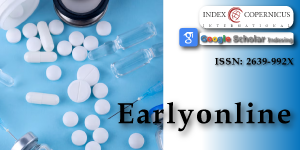In vitro, Anti-oxidant, and Anti-inflammatory Activity of Kalanchoe pinnata
Main Article Content
Abstract
Kalanchoe pinnata is a widely recognized medicinal plant known for its antioxidant and anti-inflammatory properties. This study explores its in-vitro antioxidant and anti-inflammatory activities, highlighting its potential for pharmaceutical and biomedical applications. The research innovatively assesses its bioactive components using DPPH radical scavenging, nitric oxide inhibition assays, and phenolic content analysis. Results demonstrated significant antioxidant activity with IC50 values comparable to ascorbic acid, along with notable anti-inflammatory effects via nitric oxide inhibition. These findings emphasize Kalanchoe pinnata’s potential as a source for developing antioxidant and anti-inflammatory therapeutics. Further investigation into bioactive compound isolation and mechanistic pathways is recommended to clarify its pharmacological efficacy.
Article Details
Copyright (c) 2025 Menu WMS.

This work is licensed under a Creative Commons Attribution 4.0 International License.
Kumar Biswas S, Chowdhury A, Das J, Hosen SM, Uddin R, Rahaman MS. A review of the traditional medicinal uses of Kalanchoe pinnata (Crassulaceae). Int J Pharm Pharmacol. 2021;10(1):1–5. Available from: https://www.internationalscholarsjournals.com/articles/a-review-of-the-traditional-medicinal-uses-of-kalanchoe-pinnata-crassulaceae.pdf
Zhang X, Sun Y, Chen L, Li Y, Yang L. Pharmacological properties and potential medicinal applications of Kalanchoe pinnata: A comprehensive review. Phytochem Rev. 2018;17(2):305–318.
Anandan J, Shanmugam R. Antioxidant, anti-inflammatory, and antimicrobial activity of the Kalanchoe pinnata and Piper longum formulation against oral pathogens. Cureus. 2024;16(4). Available from: https://doi.org/10.7759/cureus.57824
Quintero EJ, León EG de, Morán-Pinzón J, Mero A, León E, Cano LPP, Rica C. Evaluation of the leaf extracts of Kalanchoe pinnata and Kalanchoe daigremontiana chemistry, antioxidant and anti-inflammatory activity. EJMP. 2021;32(5):45–54. Available from: https://doi.org/10.9734/EJMP/2021/v32i530392
Reuter S, Gupta SC, Chaturvedi MM, Aggarwal BB. Oxidative stress, inflammation, and cancer: How are they linked? Free Radic Biol Med. 2010;49(11):1603–1616. Available from: https://doi.org/10.1016/j.freeradbiomed.2010.09.006
Verma S. Medicinal plants with anti-inflammatory activity. J Phytopharmacol. 2016;5(4):157–159. Available from: https://doi.org/10.31254/phyto.2016.5407
Lobo V, Patil A, Phatak A, Chandra N. Free radicals, antioxidants and functional foods: Impact on human health. Pharmacogn Rev. 2010;4(8):118–126. Available from: https://doi.org/10.4103/0973-7847.70902
Ferreira RT, Araújo M, Coutinho S, Malvar C, Costa EA, Florentino IF, Vanderlinde FA. Mechanisms underlying the antinociceptive, antiedematogenic, and anti-inflammatory activity of the main flavonoid from Kalanchoe pinnata. 2014. Available from: https://doi.org/10.1155/2014/429256
Saeed K, Farhan M, Chughtai J, Khaliq A, Mehmood T, Khalid MZ, Lengemukonzo E. Impact of extraction techniques and process optimization on antioxidant and antibacterial potential of Kalanchoe pinnata leaf extract. Int J Food Prop. 2024;27(1):909–926. Available from: https://doi.org/10.1080/10942912.2024.2373796
Calder PC. Eicosanoids. Essays Biochem. 2020;64(3):423–441. Available from: https://doi.org/10.1042/EBC20190083
Smith WL, DeWitt DL, Garavito RM. Cyclooxygenases: Structural, cellular, and molecular biology. Annu Rev Biochem. 2000;69(1):145–182. Available from: https://doi.org/10.1146/annurev.biochem.69.1.145
Adinortey MB, Galyuon IKA, Asamoah NO. Kalanchoe pinnata: A review of its ethnomedicinal uses, biological activities, and phytochemical constituents. J Med Plants Res. 2013;7(14):2338–2346.
Brand-Williams W, Cuvelier ME, Berset C. Use of a free radical method to evaluate antioxidant activity. LWT Food Sci Technol. 1995;28(1):25–30. Available from: https://doi.org/10.1016/S0023-6438(95)80008-5
Griess P. On a new reagent for nitrous acid. Ann Chem. 1879;130(2):307–310.
Zawirska-Wojtasiak R, Jankowska B, Piechowska P, Mildner-S. Vitamin C and aroma composition of fresh leaves from Kalanchoe pinnata and Kalanchoe daigremontiana. Sci Rep. 2019;1–8. Available from: https://doi.org/10.1038/s41598-019-56359-1
Benjamaa R, Elbouny H, Errati H, Moujanni A, Kaushik N, Gupta R. Comparative evaluation of antioxidant activity, total phenolic content, anti-inflammatory, and antibacterial potential of Euphorbia-derived functional products. Front Pharmacol. 2024;1–18. Available from: https://doi.org/10.3389/fphar.2024.1345340
Rajsekhar PB, Arvind Bharani RS, Ramachandran M, Jini Angel K, Sharadha Priya Vardhini. The “Wonder Plant” Kalanchoe pinnata (Linn.) Pers.: A review. J Appl Pharm Sci. 2016;6(3):151–158. Available from: https://doi.org/10.7324/JAPS.2016.60326
Harborne JB. Phytochemical Methods: A Guide to Modern Techniques of Plant Analysis. Springer Science & Business Media; 1998. Available from: https://doi.org/10.1007/978-94-009-5921-7
Mizushima Y, Kobayashi M. Interaction of anti-inflammatory drugs with serum proteins, especially with some biologically active proteins. J Pharm Pharmacol. 1968;20(3):169–173. Available from: https://doi.org/10.1111/j.2042-7158.1968.tb09718.x
Singleton VL, Rossi JA. Colorimetry of total phenolics with phosphomolybdic-phosphotungstic acid reagents. Am J Enol Vitic. 1965;16(3):144–158. Available from: https://doi.org/10.5344/ajev.1965.16.3.144
Oyaizu M. Studies on products of browning reaction: Antioxidative activities of products of browning reaction prepared from glucosamine. Jpn J Nutr Diet. 1986;44(6):307–315. Available from: https://doi.org/10.5264/eiyogakuzashi.44.307
Sharma N. Antioxidant and anti-inflammatory properties of medicinal plants: A review. Asian J Pharm Clin Res. 2016;9(4):33–36.
Prieto P, Pineda M, Aguilar M. Spectrophotometric quantitation of antioxidant capacity through the formation of a phosphomolybdenum complex: Specific application to the determination of vitamin E. Anal Biochem. 1999;269(2):337–341. Available from: https://doi.org/10.1006/abio.1999.4019
Mizushima Y, Kobayashi M. Interaction of anti-inflammatory drugs with serum proteins, especially with some biologically active proteins. J Pharm Pharmacol. 1968;20(3):169–173. Available from: https://doi.org/10.1111/j.2042-7158.1968.tb09718.x
Timsina B. Evaluation of antioxidant, anti-inflammatory, and antimicrobial activity of medicinal plants. J Med Plants Res. 2017;11(22):362–370.
Akinmoladun FO. Phytochemical constituents and antioxidant properties of extracts from the leaves of Chromolaena odorata. Sci Res Essays. 2010;5(16):2201–2205.
Ramon P, Bergmann D, Abdulla H, Sparks J, Omoruyi F. Bioactive ingredients in K. pinnata extract and synergistic effects of combined K. pinnata and metformin preparations on antioxidant activities in diabetic and non-diabetic skeletal muscle cells. Int J Mol Sci. 2023;24(7):6211. Available from: https://doi.org/10.3390/ijms24076211
Fabricant DS, Farnsworth NR. The value of plants used in traditional medicine for drug discovery. Environ Health Perspect. 2001;109(Suppl 1):69–75. Available from: https://doi.org/10.1289/ehp.01109s169
Kamboj A, Saluja AK. Bryophyllum pinnatum (Lam.) Kurz: Phytochemical and pharmacological profile: A review. Pharmacogn Rev. 2009;3(6):364–374. Available from: https://phcogrev.com/article/2009/3/6-13
Ojewole JA. Antinociceptive, anti-inflammatory and antidiabetic properties of Bryophyllum pinnatum (Crassulaceae) leaf aqueous extract. J Ethnopharmacol. 2005;99(1):13–19. Available from: https://doi.org/10.1016/j.jep.2005.01.025





